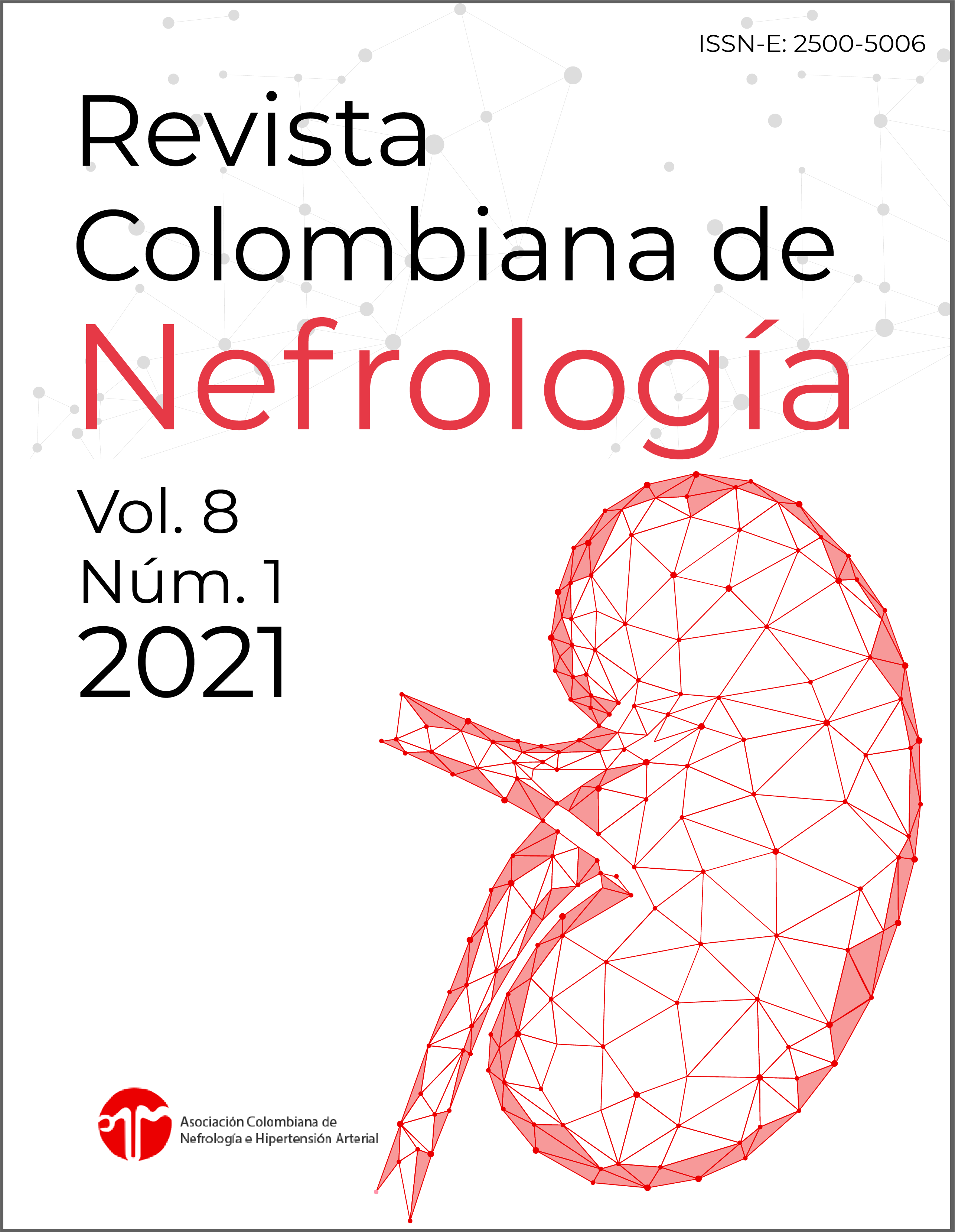Resumen
La glomerulonefritis post-infecciosa puede ser desencadenada por virus, bacterias hongos o parásitos. Estos agentes pueden desencadenar una respuesta inflamatoria no controlada sobre el glomérulo y túbulo renal, donde participan la formación de inmunocomplejos y la activación de la via alterna del complemento. Se han planteado múltiples mecanismos que involucran la generación de anticuerpos contra proteínas que hacen parte de la estructura del estreptococo y son conocidos como antígenos nefritogénicos de los cuales los màs estudiados recientemente son la exotoxina pirogénica B del estreptoco y la gliceraldehido 3 fosfato deshidrogenasa.
La glomerulonefritis post-estreptocóccica usualmente tiene un curso benigno con complicaciones que pueden ser controlados con manejo de soporte. Es infrecuente en el adulto sin embargo, cuando se produce tiene peor pronóstico en comparación con los niños. Las lesiones proliferativas extracapilares son inusuales en la glomerulonefritis post-estreptocòccica. Se presenta caso de un paciente adulto que debuto con una glomerulonefritis rápidamente progresiva secundario a una infección por estreptococo.
Citas
Kambham N. Postinfectious glomerulonephritis. Adv Anat Pathol. 2012 Sep;19(5):338–47.
Rodriguez-Iturbe B, Batsford S. Pathogenesis of poststreptococcal glomerulonephritis a century after Clemens von Pirquet. Kidney Int. 2007 Jun;71(11):1094–104.
Carapetis JR, Steer AC, Mulholland EK, Weber M. The global burden of group A streptococcal diseases. Lancet Infect Dis. 2005 Nov;5(11):685–94.
Coppo R, Gianoglio B, G Porcellini M, Maringhini S. Frequency of renal diseases and clinical indications for renal biopsy in children (report of the Italian National Registry of Renal Biopsies in Children).Group of Renal Immunopathology of the Italian Society of Pediatric Nephrology and Group of Renal Immunopathology of the Italian Society of Nephrology. Vol. 13, Nephrology, dialysis, transplantation?: official publication of the European Dialysis and Transplant Association - European Renal Association. 1998. 293-297 p.
Simon P, Ramee MP, Autuly V, Laruelle E, Charasse C, Cam G, et al. Epidemiology of primary glomerular diseases in a French region. Variations according to period and age. Kidney Int. 1994 Oct;46(4):1192–8.
Nelson JD, Brooksaler F. Gabritschewsky—The Forgotten Man of Scarlet Fever. Am J Dis Child [Internet]. 1971 Mar 1;121(3):189–94. Available from: https://dx.doi.org/10.1001/archpedi.1971.02100140055001
DOCHEZ AR. THE SIGNIFICANCE OF STREPTOCOCCUS HEMOLYTICUS IN SCARLET FEVER: AND THE PREPARATION OF A SPECIFIC ANTISCARLATINAL SERUM BY IMMUNIZATION OF THE HORSE TO STREPTOCOCCUS HEMOLYTICUS-SCARLATINAE. J Am Med Assoc [Internet]. 1924 Feb 16;82(7):542–4. Available from: https://dx.doi.org/10.1001/jama.1924.02650330034013
Bisno AL, Brito MO, Collins CM. Molecular basis of group A streptococcal virulence. Lancet Infect Dis. 2003 Apr;3(4):191–200.
Oda T, Yoshizawa N, Yamakami K, Tamura K, Kuroki A, Sugisaki T, et al. Localization of nephritis-associated plasmin receptor in acute poststreptococcal glomerulonephritis. Hum Pathol. 2010 Sep;41(9):1276–85
Villarreal HJ, Fischetti VA, van de Rijn I, Zabriskie JB. The occurrence of a protein in the extracellular products of streptococci isolated from patients with acute glomerulonephritis. J Exp Med. 1979 Feb;149(2):459–72.
Lottenberg R, Broder CC, Boyle MD. Identification of a specific receptor for plasmin on a group A streptococcus. Infect Immun. 1987 Aug;55(8):1914–8.
Broeseker TA, Boyle MD, Lottenberg R. Characterization of the interaction of human plasmin with its specific receptor on a group A streptococcus. Microb Pathog. 1988 Jul;5(1):19–27.
Pancholi V, Fischetti VA. A major surface protein on group A streptococci is a glyceraldehyde-3-phosphate-dehydrogenase with multiple binding activity. J Exp Med. 1992 Aug;176(2):415–26.
Poon-King R, Bannan J, Viteri A, Cu G, Zabriskie JB. Identification of an extracellular plasmin binding protein from nephritogenic streptococci. J Exp Med. 1993 Aug;178(2):759–63.
Oda T, Yoshizawa N, Yamakami K, Sakurai Y, Takechi H, Yamamoto K, et al. The role of nephritis-associated plasmin receptor (NAPlr) in glomerulonephritis associated with streptococcal infection. J Biomed Biotechnol. 2012;2012:417675.
Yamakami K, Yoshizawa N, Wakabayashi K, Takeuchi A, Tadakuma T, Boyle MD. The potential role for nephritis-associated plasmin receptor in acute poststreptococcal glomerulonephritis. Methods. 2000 Jun;21(2):185–97.
Yoshizawa N, Yamakami K, Fujino M, Oda T, Tamura K, Matsumoto K, et al. Nephritis-associated plasmin receptor and acute poststreptococcal glomerulonephritis: characterization of the antigen and associated immune response. J Am Soc Nephrol. 2004 Jul;15(7):1785–93.
Parra G, Rodríguez-Iturbe B, Batsford S, Vogt A, Mezzano S, Olavarría F, et al. Antibody to streptococcal zymogen in the serum of patients with acute glomerulonephritis: A multicentric study. Kidney Int [Internet]. 1998 Aug 1;54(2):509–17. Available from: https://doi.org/10.1046/j.1523-1755.1998.00012.x
Cu GA, Mezzano S, Bannan JD, Zabriskie JB. Immunohistochemical and serological evidence for the role of streptococcal proteinase in acute post-streptococcal glomerulonephritis. Kidney Int [Internet]. 1998 Sep 1;54(3):819–26. Available from: https://doi.org/10.1046/j.1523-1755.1998.00052.x
Batsford SR, Mezzano S, Mihatsch M, Schiltz E, Rodriguez-Iturbe B. Is the nephritogenic antigen in post-streptococcal glomerulonephritis pyrogenic exotoxin B (SPE B) or GAPDH? Kidney Int. 2005 Sep;68(3):1120–9.
Wen Y-K. The spectrum of adult postinfectious glomerulonephritis in the new millennium. Ren Fail. 2009;31(8):676–82.
Dewan D, Gulati S, Sharma RK, Prasad N, Jain M, Gupta A, et al. Clinical spectrum and outcome of crescentic glomerulonephritis in children in developing countries. Pediatr Nephrol. 2008 Mar;23(3):389–94.
A clinico-pathologic study of crescentic glomerulonephritis in 50 children. A report of the Southwest Pediatric Nephrology Study Group. Kidney Int. 1985 Feb;27(2):450–8.
El-Husseini AA, El-Agroudy AE, Moustafa FE, Fouda MA, Sobh MA. Impact of clinical and histopathological factors on outcome of Egyptian patients with crescentic glomerulonephritis. Int Urol Nephrol. 2003;35(4):543–51.
Sasatomi Y, Kiyoshi Y, Takabeyashi S. A clinical and pathological study on the characteristics and factors influencing the prognosis of crescentic glomerulonephritis using a cluster analysis. Vol. 49, Pathology International. 1999. 781-785 p.

Esta obra está bajo una licencia internacional Creative Commons Atribución-NoComercial-SinDerivadas 4.0.
Derechos de autor 2021 Revista Colombiana de Nefrología


